PACT Framework: Ethical Decision-Making in IT Project Management
VerifiedAdded on 2023/06/16
|7
|1478
|363
Case Study
AI Summary
This case study employs the Problem, Action, Consequence, Technique (PACT) framework to analyze an ethical dilemma in IT project management. The scenario involves a test manager, Ken, facing pressure to release an untested system due to client demands. The study identifies the ethical problems, including compromised system quality and potential operational errors. It explores alternative actions, such as presenting the risks of untested delivery to senior management and clients, and analyzes the consequences using ethical theories like Consequentialism, Deontology, and Virtue Ethics. The recommended solution involves transparent communication of potential issues and advocating for additional resources to expedite testing, ensuring both project delivery and ethical standards are met. Desklib provides access to similar case studies and solved assignments for students.
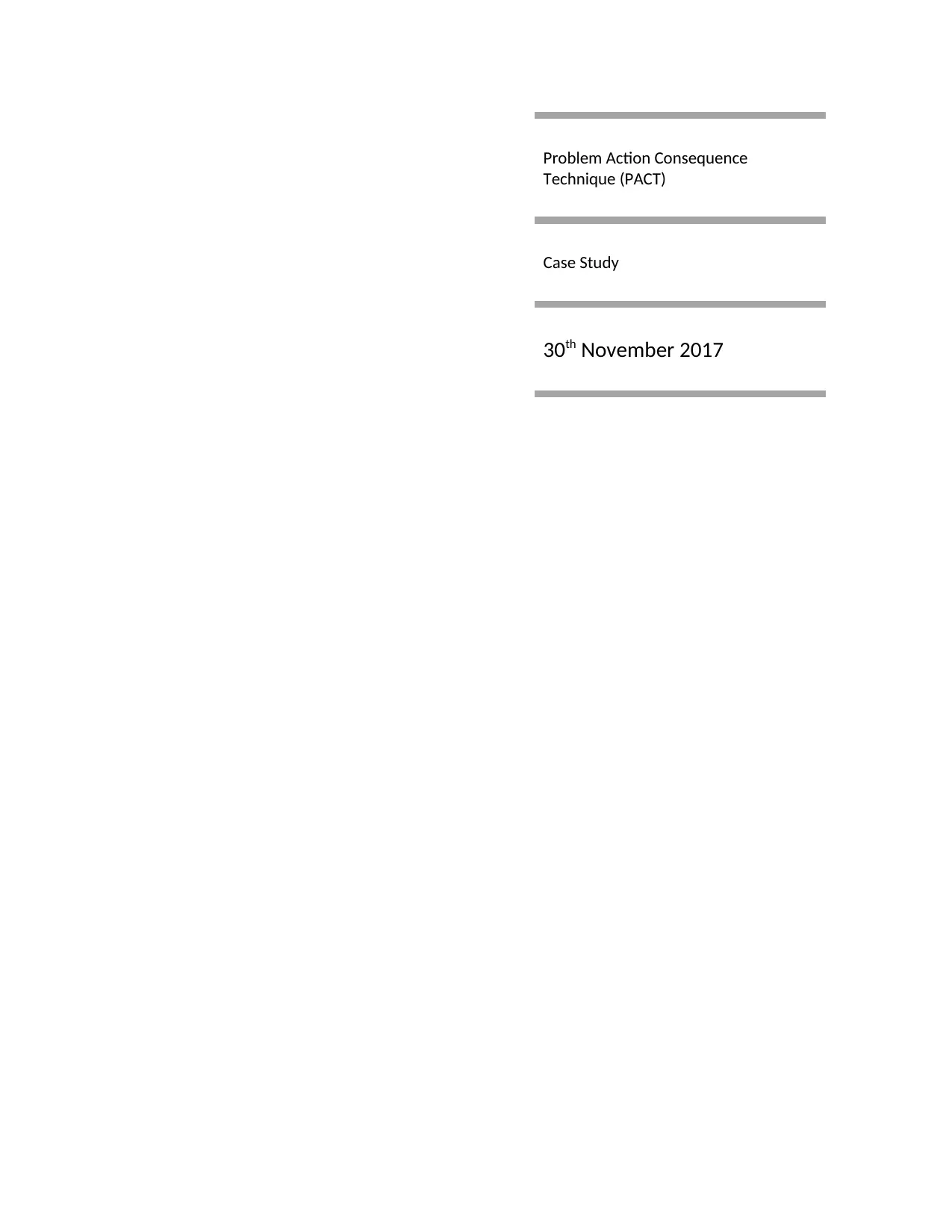
Problem Action Consequence
Technique (PACT)
Case Study
30th November 2017
Technique (PACT)
Case Study
30th November 2017
Paraphrase This Document
Need a fresh take? Get an instant paraphrase of this document with our AI Paraphraser
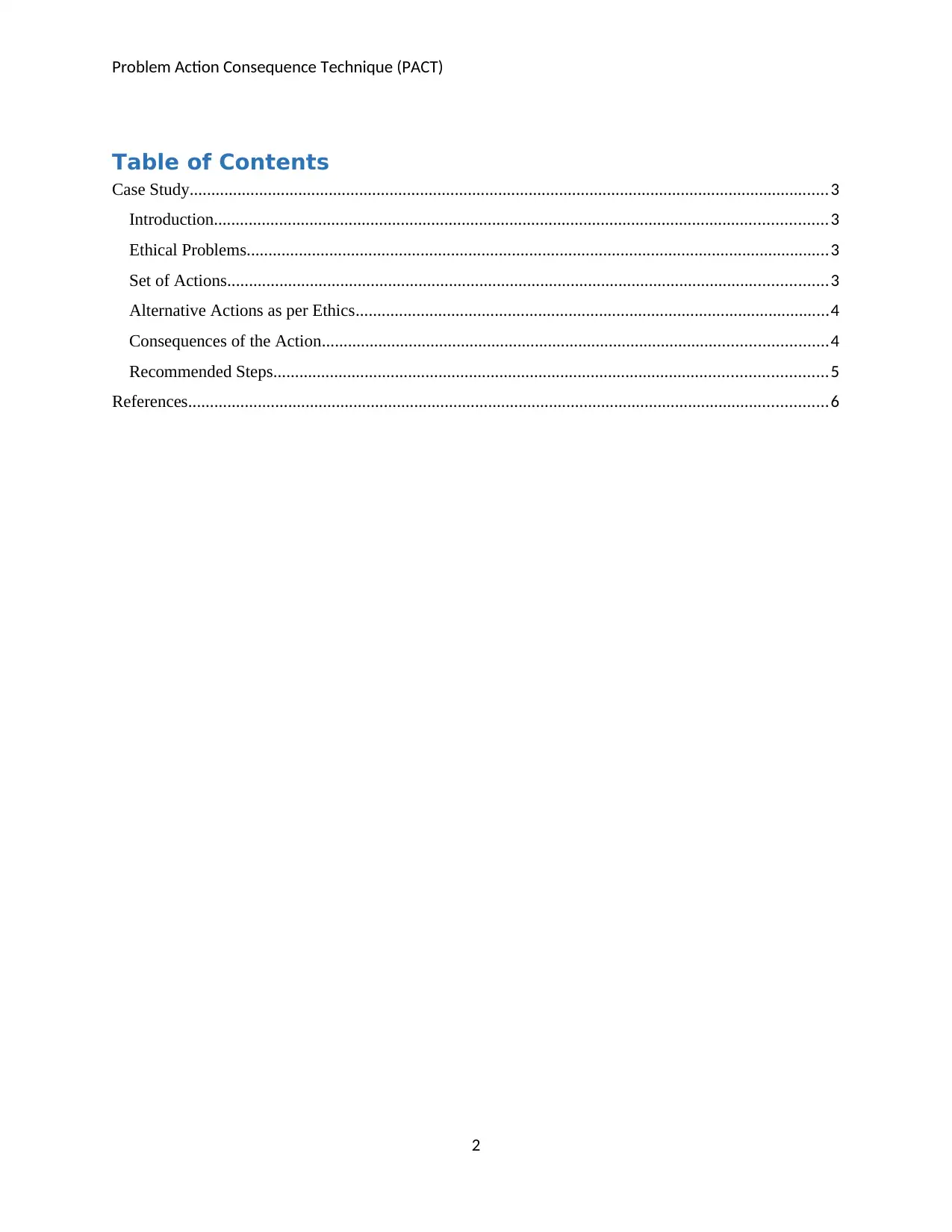
Problem Action Consequence Technique (PACT)
Table of Contents
Case Study...................................................................................................................................................3
Introduction.............................................................................................................................................3
Ethical Problems......................................................................................................................................3
Set of Actions..........................................................................................................................................3
Alternative Actions as per Ethics.............................................................................................................4
Consequences of the Action....................................................................................................................4
Recommended Steps...............................................................................................................................5
References...................................................................................................................................................6
2
Table of Contents
Case Study...................................................................................................................................................3
Introduction.............................................................................................................................................3
Ethical Problems......................................................................................................................................3
Set of Actions..........................................................................................................................................3
Alternative Actions as per Ethics.............................................................................................................4
Consequences of the Action....................................................................................................................4
Recommended Steps...............................................................................................................................5
References...................................................................................................................................................6
2
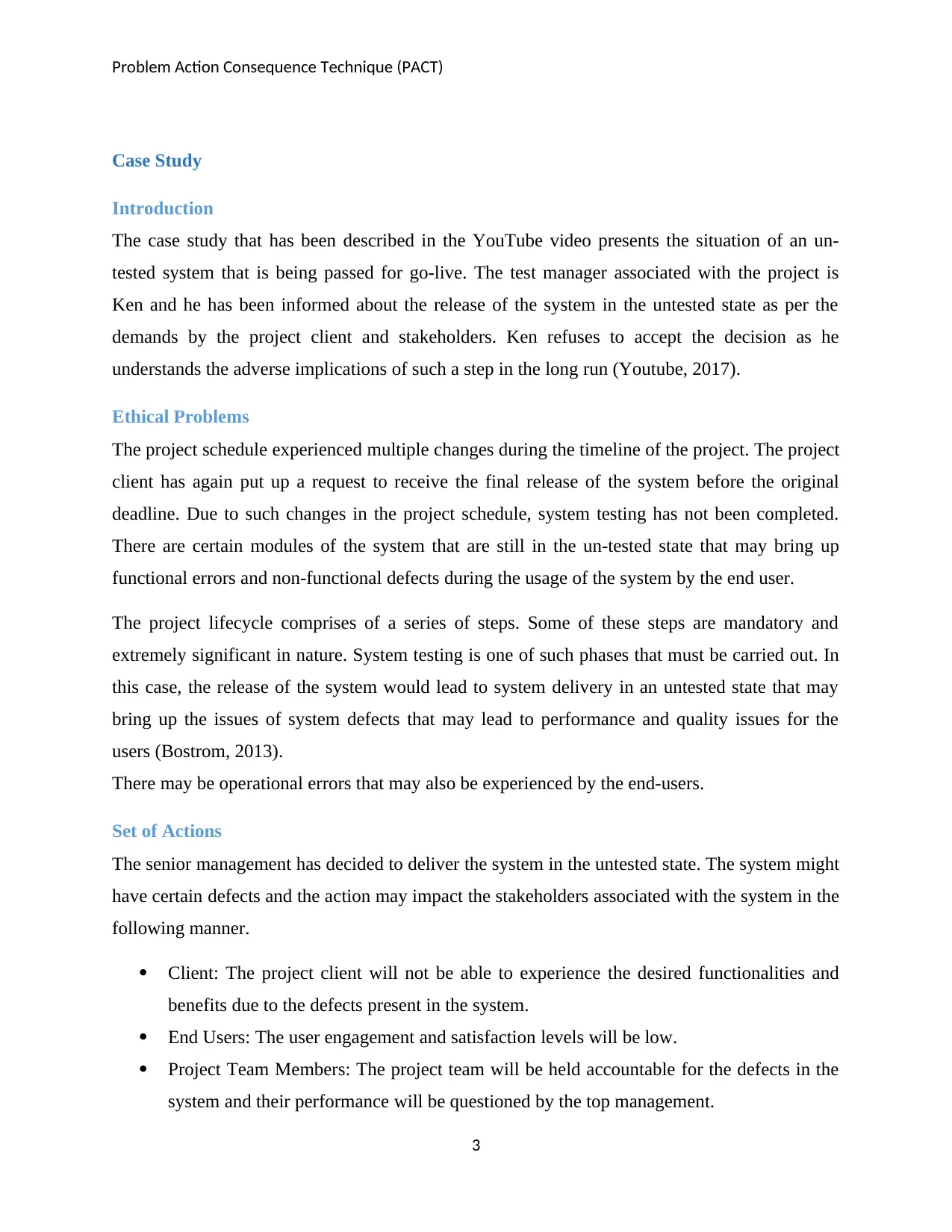
Problem Action Consequence Technique (PACT)
Case Study
Introduction
The case study that has been described in the YouTube video presents the situation of an un-
tested system that is being passed for go-live. The test manager associated with the project is
Ken and he has been informed about the release of the system in the untested state as per the
demands by the project client and stakeholders. Ken refuses to accept the decision as he
understands the adverse implications of such a step in the long run (Youtube, 2017).
Ethical Problems
The project schedule experienced multiple changes during the timeline of the project. The project
client has again put up a request to receive the final release of the system before the original
deadline. Due to such changes in the project schedule, system testing has not been completed.
There are certain modules of the system that are still in the un-tested state that may bring up
functional errors and non-functional defects during the usage of the system by the end user.
The project lifecycle comprises of a series of steps. Some of these steps are mandatory and
extremely significant in nature. System testing is one of such phases that must be carried out. In
this case, the release of the system would lead to system delivery in an untested state that may
bring up the issues of system defects that may lead to performance and quality issues for the
users (Bostrom, 2013).
There may be operational errors that may also be experienced by the end-users.
Set of Actions
The senior management has decided to deliver the system in the untested state. The system might
have certain defects and the action may impact the stakeholders associated with the system in the
following manner.
Client: The project client will not be able to experience the desired functionalities and
benefits due to the defects present in the system.
End Users: The user engagement and satisfaction levels will be low.
Project Team Members: The project team will be held accountable for the defects in the
system and their performance will be questioned by the top management.
3
Case Study
Introduction
The case study that has been described in the YouTube video presents the situation of an un-
tested system that is being passed for go-live. The test manager associated with the project is
Ken and he has been informed about the release of the system in the untested state as per the
demands by the project client and stakeholders. Ken refuses to accept the decision as he
understands the adverse implications of such a step in the long run (Youtube, 2017).
Ethical Problems
The project schedule experienced multiple changes during the timeline of the project. The project
client has again put up a request to receive the final release of the system before the original
deadline. Due to such changes in the project schedule, system testing has not been completed.
There are certain modules of the system that are still in the un-tested state that may bring up
functional errors and non-functional defects during the usage of the system by the end user.
The project lifecycle comprises of a series of steps. Some of these steps are mandatory and
extremely significant in nature. System testing is one of such phases that must be carried out. In
this case, the release of the system would lead to system delivery in an untested state that may
bring up the issues of system defects that may lead to performance and quality issues for the
users (Bostrom, 2013).
There may be operational errors that may also be experienced by the end-users.
Set of Actions
The senior management has decided to deliver the system in the untested state. The system might
have certain defects and the action may impact the stakeholders associated with the system in the
following manner.
Client: The project client will not be able to experience the desired functionalities and
benefits due to the defects present in the system.
End Users: The user engagement and satisfaction levels will be low.
Project Team Members: The project team will be held accountable for the defects in the
system and their performance will be questioned by the top management.
3
⊘ This is a preview!⊘
Do you want full access?
Subscribe today to unlock all pages.

Trusted by 1+ million students worldwide
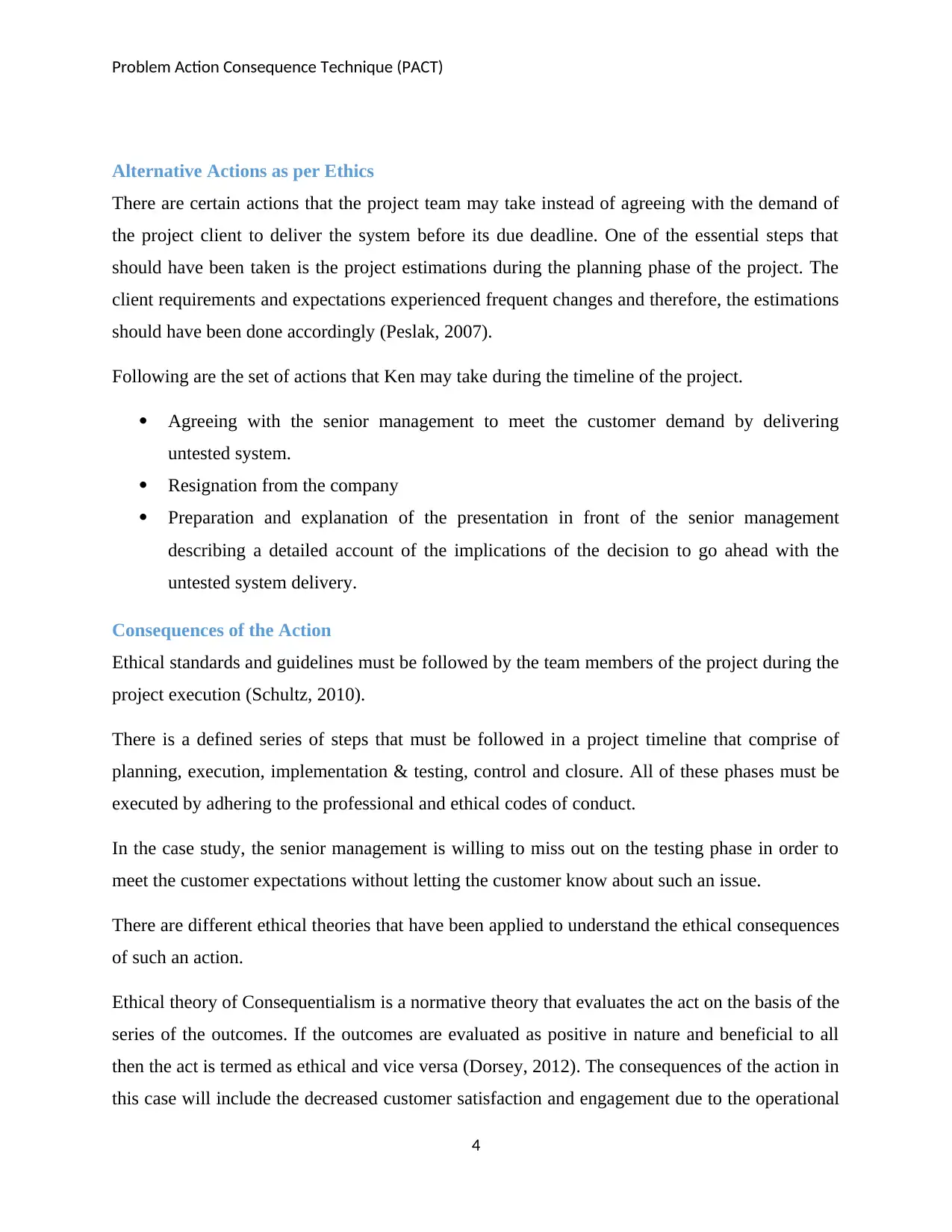
Problem Action Consequence Technique (PACT)
Alternative Actions as per Ethics
There are certain actions that the project team may take instead of agreeing with the demand of
the project client to deliver the system before its due deadline. One of the essential steps that
should have been taken is the project estimations during the planning phase of the project. The
client requirements and expectations experienced frequent changes and therefore, the estimations
should have been done accordingly (Peslak, 2007).
Following are the set of actions that Ken may take during the timeline of the project.
Agreeing with the senior management to meet the customer demand by delivering
untested system.
Resignation from the company
Preparation and explanation of the presentation in front of the senior management
describing a detailed account of the implications of the decision to go ahead with the
untested system delivery.
Consequences of the Action
Ethical standards and guidelines must be followed by the team members of the project during the
project execution (Schultz, 2010).
There is a defined series of steps that must be followed in a project timeline that comprise of
planning, execution, implementation & testing, control and closure. All of these phases must be
executed by adhering to the professional and ethical codes of conduct.
In the case study, the senior management is willing to miss out on the testing phase in order to
meet the customer expectations without letting the customer know about such an issue.
There are different ethical theories that have been applied to understand the ethical consequences
of such an action.
Ethical theory of Consequentialism is a normative theory that evaluates the act on the basis of the
series of the outcomes. If the outcomes are evaluated as positive in nature and beneficial to all
then the act is termed as ethical and vice versa (Dorsey, 2012). The consequences of the action in
this case will include the decreased customer satisfaction and engagement due to the operational
4
Alternative Actions as per Ethics
There are certain actions that the project team may take instead of agreeing with the demand of
the project client to deliver the system before its due deadline. One of the essential steps that
should have been taken is the project estimations during the planning phase of the project. The
client requirements and expectations experienced frequent changes and therefore, the estimations
should have been done accordingly (Peslak, 2007).
Following are the set of actions that Ken may take during the timeline of the project.
Agreeing with the senior management to meet the customer demand by delivering
untested system.
Resignation from the company
Preparation and explanation of the presentation in front of the senior management
describing a detailed account of the implications of the decision to go ahead with the
untested system delivery.
Consequences of the Action
Ethical standards and guidelines must be followed by the team members of the project during the
project execution (Schultz, 2010).
There is a defined series of steps that must be followed in a project timeline that comprise of
planning, execution, implementation & testing, control and closure. All of these phases must be
executed by adhering to the professional and ethical codes of conduct.
In the case study, the senior management is willing to miss out on the testing phase in order to
meet the customer expectations without letting the customer know about such an issue.
There are different ethical theories that have been applied to understand the ethical consequences
of such an action.
Ethical theory of Consequentialism is a normative theory that evaluates the act on the basis of the
series of the outcomes. If the outcomes are evaluated as positive in nature and beneficial to all
then the act is termed as ethical and vice versa (Dorsey, 2012). The consequences of the action in
this case will include the decreased customer satisfaction and engagement due to the operational
4
Paraphrase This Document
Need a fresh take? Get an instant paraphrase of this document with our AI Paraphraser
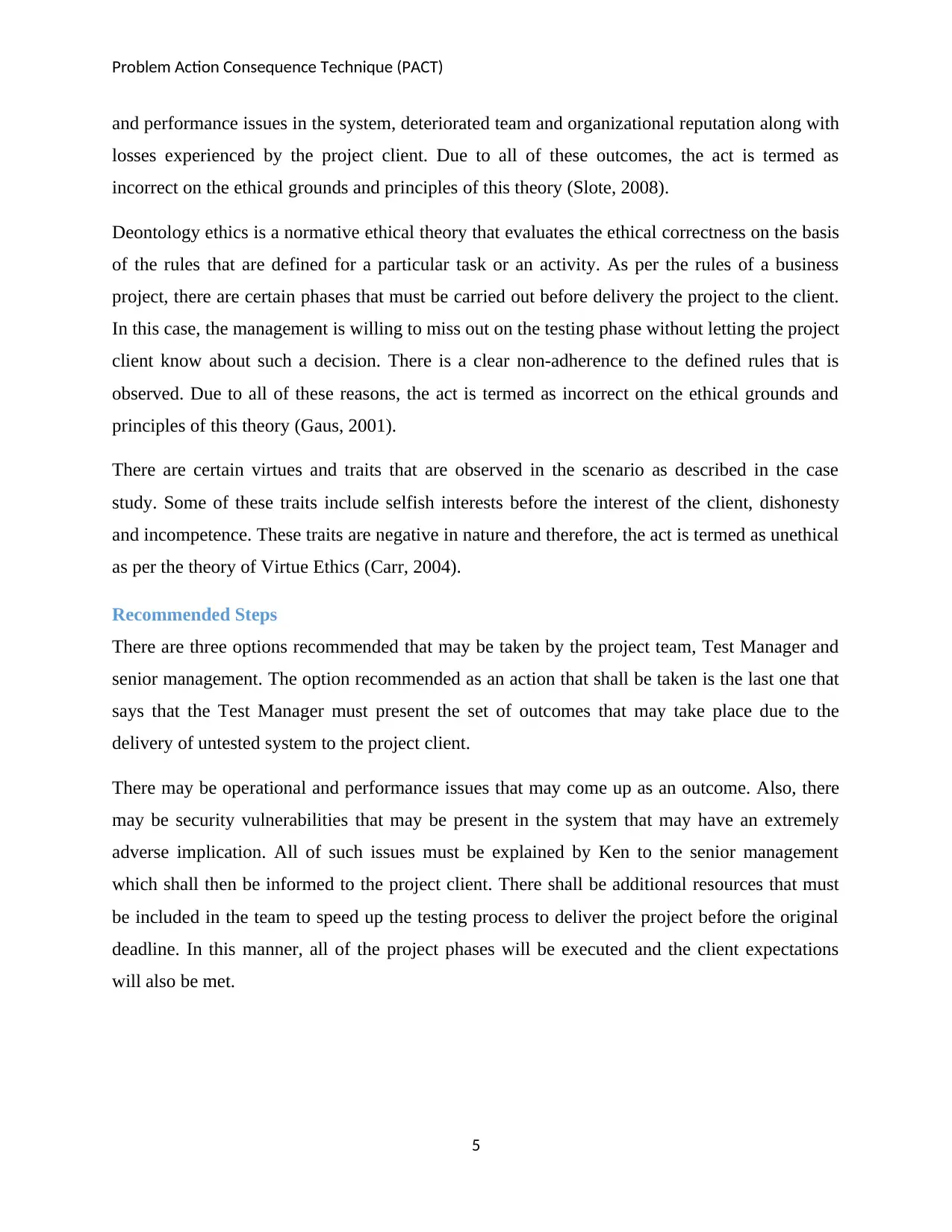
Problem Action Consequence Technique (PACT)
and performance issues in the system, deteriorated team and organizational reputation along with
losses experienced by the project client. Due to all of these outcomes, the act is termed as
incorrect on the ethical grounds and principles of this theory (Slote, 2008).
Deontology ethics is a normative ethical theory that evaluates the ethical correctness on the basis
of the rules that are defined for a particular task or an activity. As per the rules of a business
project, there are certain phases that must be carried out before delivery the project to the client.
In this case, the management is willing to miss out on the testing phase without letting the project
client know about such a decision. There is a clear non-adherence to the defined rules that is
observed. Due to all of these reasons, the act is termed as incorrect on the ethical grounds and
principles of this theory (Gaus, 2001).
There are certain virtues and traits that are observed in the scenario as described in the case
study. Some of these traits include selfish interests before the interest of the client, dishonesty
and incompetence. These traits are negative in nature and therefore, the act is termed as unethical
as per the theory of Virtue Ethics (Carr, 2004).
Recommended Steps
There are three options recommended that may be taken by the project team, Test Manager and
senior management. The option recommended as an action that shall be taken is the last one that
says that the Test Manager must present the set of outcomes that may take place due to the
delivery of untested system to the project client.
There may be operational and performance issues that may come up as an outcome. Also, there
may be security vulnerabilities that may be present in the system that may have an extremely
adverse implication. All of such issues must be explained by Ken to the senior management
which shall then be informed to the project client. There shall be additional resources that must
be included in the team to speed up the testing process to deliver the project before the original
deadline. In this manner, all of the project phases will be executed and the client expectations
will also be met.
5
and performance issues in the system, deteriorated team and organizational reputation along with
losses experienced by the project client. Due to all of these outcomes, the act is termed as
incorrect on the ethical grounds and principles of this theory (Slote, 2008).
Deontology ethics is a normative ethical theory that evaluates the ethical correctness on the basis
of the rules that are defined for a particular task or an activity. As per the rules of a business
project, there are certain phases that must be carried out before delivery the project to the client.
In this case, the management is willing to miss out on the testing phase without letting the project
client know about such a decision. There is a clear non-adherence to the defined rules that is
observed. Due to all of these reasons, the act is termed as incorrect on the ethical grounds and
principles of this theory (Gaus, 2001).
There are certain virtues and traits that are observed in the scenario as described in the case
study. Some of these traits include selfish interests before the interest of the client, dishonesty
and incompetence. These traits are negative in nature and therefore, the act is termed as unethical
as per the theory of Virtue Ethics (Carr, 2004).
Recommended Steps
There are three options recommended that may be taken by the project team, Test Manager and
senior management. The option recommended as an action that shall be taken is the last one that
says that the Test Manager must present the set of outcomes that may take place due to the
delivery of untested system to the project client.
There may be operational and performance issues that may come up as an outcome. Also, there
may be security vulnerabilities that may be present in the system that may have an extremely
adverse implication. All of such issues must be explained by Ken to the senior management
which shall then be informed to the project client. There shall be additional resources that must
be included in the team to speed up the testing process to deliver the project before the original
deadline. In this manner, all of the project phases will be executed and the client expectations
will also be met.
5
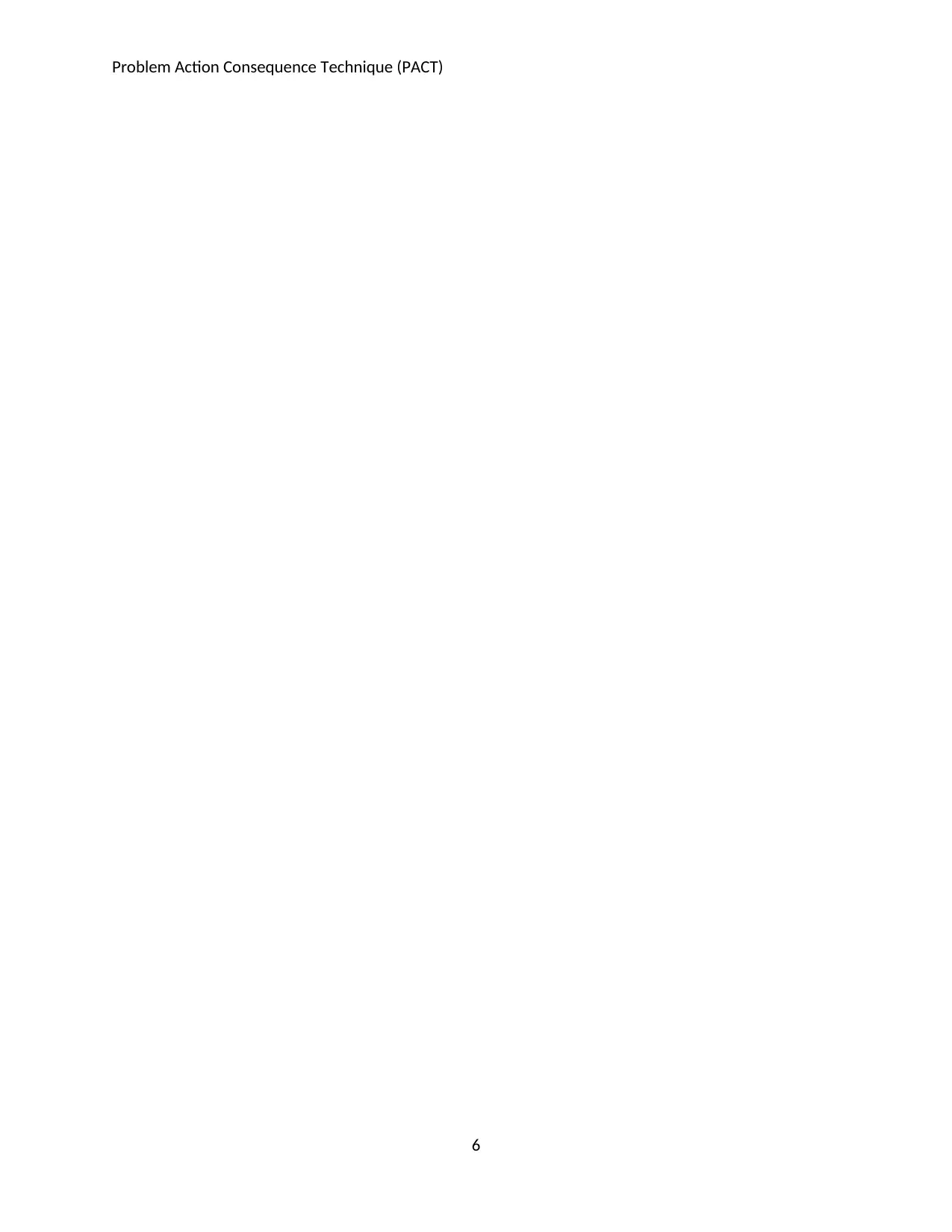
Problem Action Consequence Technique (PACT)
6
6
⊘ This is a preview!⊘
Do you want full access?
Subscribe today to unlock all pages.

Trusted by 1+ million students worldwide
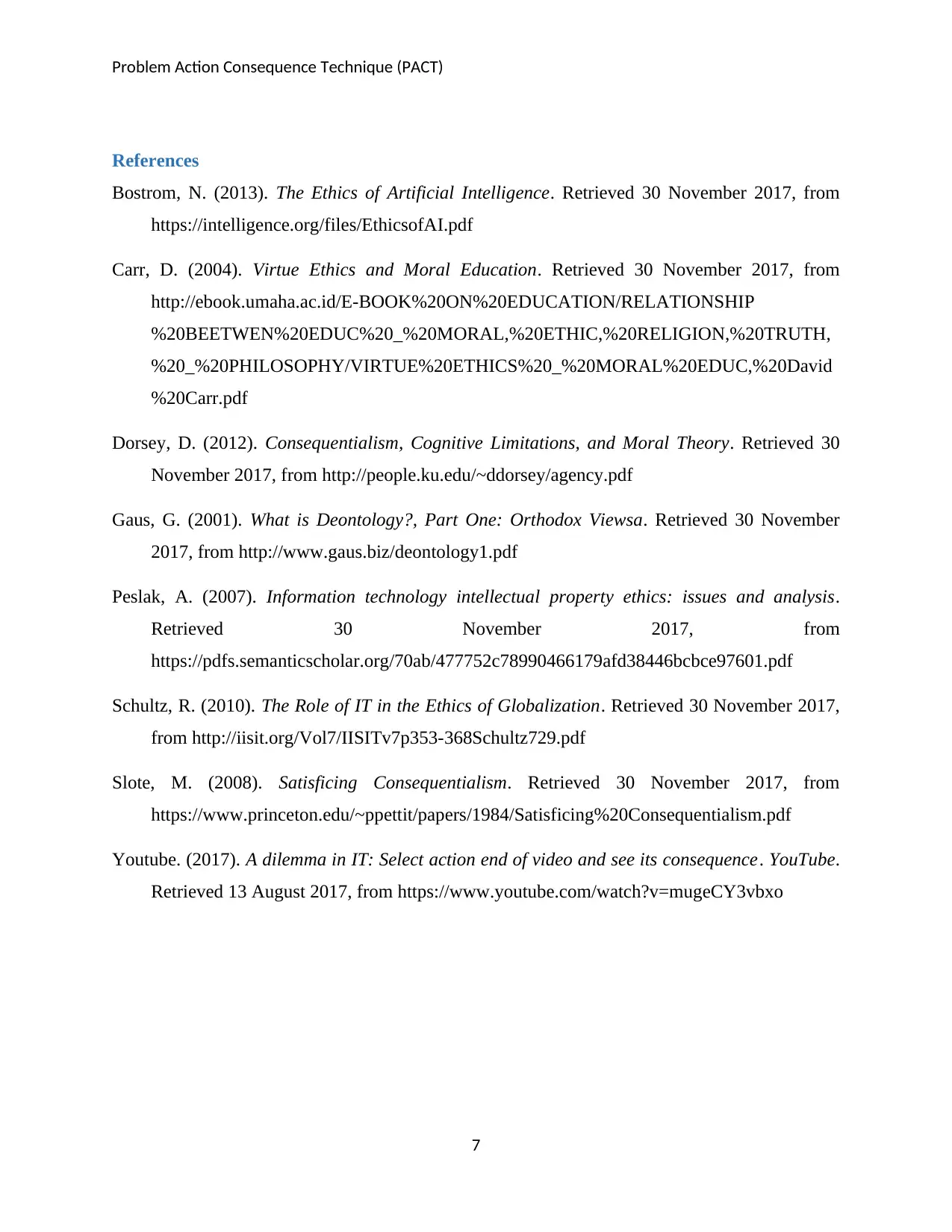
Problem Action Consequence Technique (PACT)
References
Bostrom, N. (2013). The Ethics of Artificial Intelligence. Retrieved 30 November 2017, from
https://intelligence.org/files/EthicsofAI.pdf
Carr, D. (2004). Virtue Ethics and Moral Education. Retrieved 30 November 2017, from
http://ebook.umaha.ac.id/E-BOOK%20ON%20EDUCATION/RELATIONSHIP
%20BEETWEN%20EDUC%20_%20MORAL,%20ETHIC,%20RELIGION,%20TRUTH,
%20_%20PHILOSOPHY/VIRTUE%20ETHICS%20_%20MORAL%20EDUC,%20David
%20Carr.pdf
Dorsey, D. (2012). Consequentialism, Cognitive Limitations, and Moral Theory. Retrieved 30
November 2017, from http://people.ku.edu/~ddorsey/agency.pdf
Gaus, G. (2001). What is Deontology?, Part One: Orthodox Viewsa. Retrieved 30 November
2017, from http://www.gaus.biz/deontology1.pdf
Peslak, A. (2007). Information technology intellectual property ethics: issues and analysis.
Retrieved 30 November 2017, from
https://pdfs.semanticscholar.org/70ab/477752c78990466179afd38446bcbce97601.pdf
Schultz, R. (2010). The Role of IT in the Ethics of Globalization. Retrieved 30 November 2017,
from http://iisit.org/Vol7/IISITv7p353-368Schultz729.pdf
Slote, M. (2008). Satisficing Consequentialism. Retrieved 30 November 2017, from
https://www.princeton.edu/~ppettit/papers/1984/Satisficing%20Consequentialism.pdf
Youtube. (2017). A dilemma in IT: Select action end of video and see its consequence. YouTube.
Retrieved 13 August 2017, from https://www.youtube.com/watch?v=mugeCY3vbxo
7
References
Bostrom, N. (2013). The Ethics of Artificial Intelligence. Retrieved 30 November 2017, from
https://intelligence.org/files/EthicsofAI.pdf
Carr, D. (2004). Virtue Ethics and Moral Education. Retrieved 30 November 2017, from
http://ebook.umaha.ac.id/E-BOOK%20ON%20EDUCATION/RELATIONSHIP
%20BEETWEN%20EDUC%20_%20MORAL,%20ETHIC,%20RELIGION,%20TRUTH,
%20_%20PHILOSOPHY/VIRTUE%20ETHICS%20_%20MORAL%20EDUC,%20David
%20Carr.pdf
Dorsey, D. (2012). Consequentialism, Cognitive Limitations, and Moral Theory. Retrieved 30
November 2017, from http://people.ku.edu/~ddorsey/agency.pdf
Gaus, G. (2001). What is Deontology?, Part One: Orthodox Viewsa. Retrieved 30 November
2017, from http://www.gaus.biz/deontology1.pdf
Peslak, A. (2007). Information technology intellectual property ethics: issues and analysis.
Retrieved 30 November 2017, from
https://pdfs.semanticscholar.org/70ab/477752c78990466179afd38446bcbce97601.pdf
Schultz, R. (2010). The Role of IT in the Ethics of Globalization. Retrieved 30 November 2017,
from http://iisit.org/Vol7/IISITv7p353-368Schultz729.pdf
Slote, M. (2008). Satisficing Consequentialism. Retrieved 30 November 2017, from
https://www.princeton.edu/~ppettit/papers/1984/Satisficing%20Consequentialism.pdf
Youtube. (2017). A dilemma in IT: Select action end of video and see its consequence. YouTube.
Retrieved 13 August 2017, from https://www.youtube.com/watch?v=mugeCY3vbxo
7
1 out of 7
Related Documents
Your All-in-One AI-Powered Toolkit for Academic Success.
+13062052269
info@desklib.com
Available 24*7 on WhatsApp / Email
![[object Object]](/_next/static/media/star-bottom.7253800d.svg)
Unlock your academic potential
Copyright © 2020–2025 A2Z Services. All Rights Reserved. Developed and managed by ZUCOL.





